Advanced Card Systems ACR123 ACR123 Contactless Reader User Manual
Advanced Card Systems Limited ACR123 Contactless Reader Users Manual
Users Manual
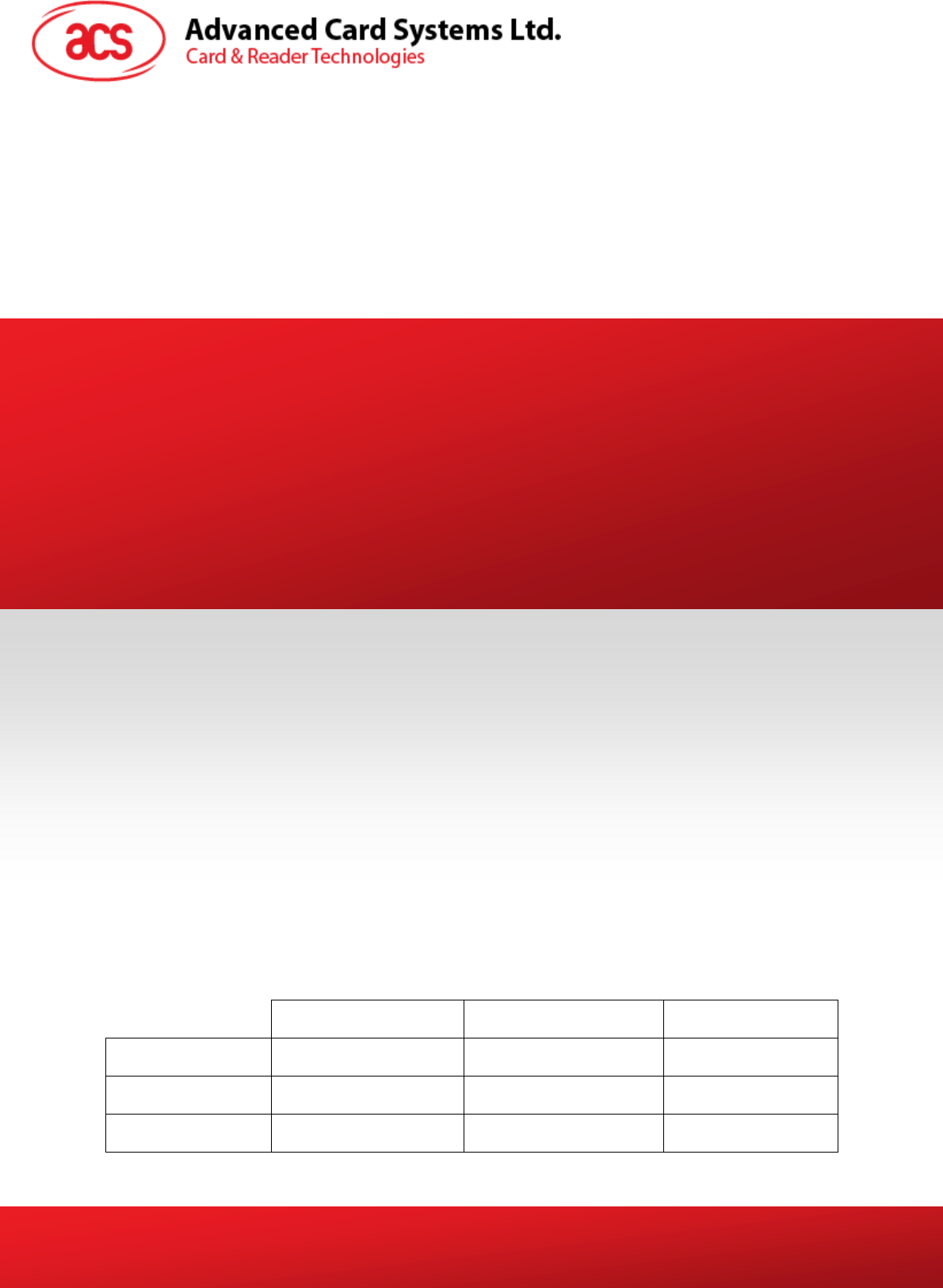
Subject to change without prior notice info@acs.com.hk
www.acs.com.hk
Name Signature Date
Prepared by: Kit Au 2013-03-27
Reviewed by:
Approved by:
ACR123 User Manual V1.00
ACR123
User Manual
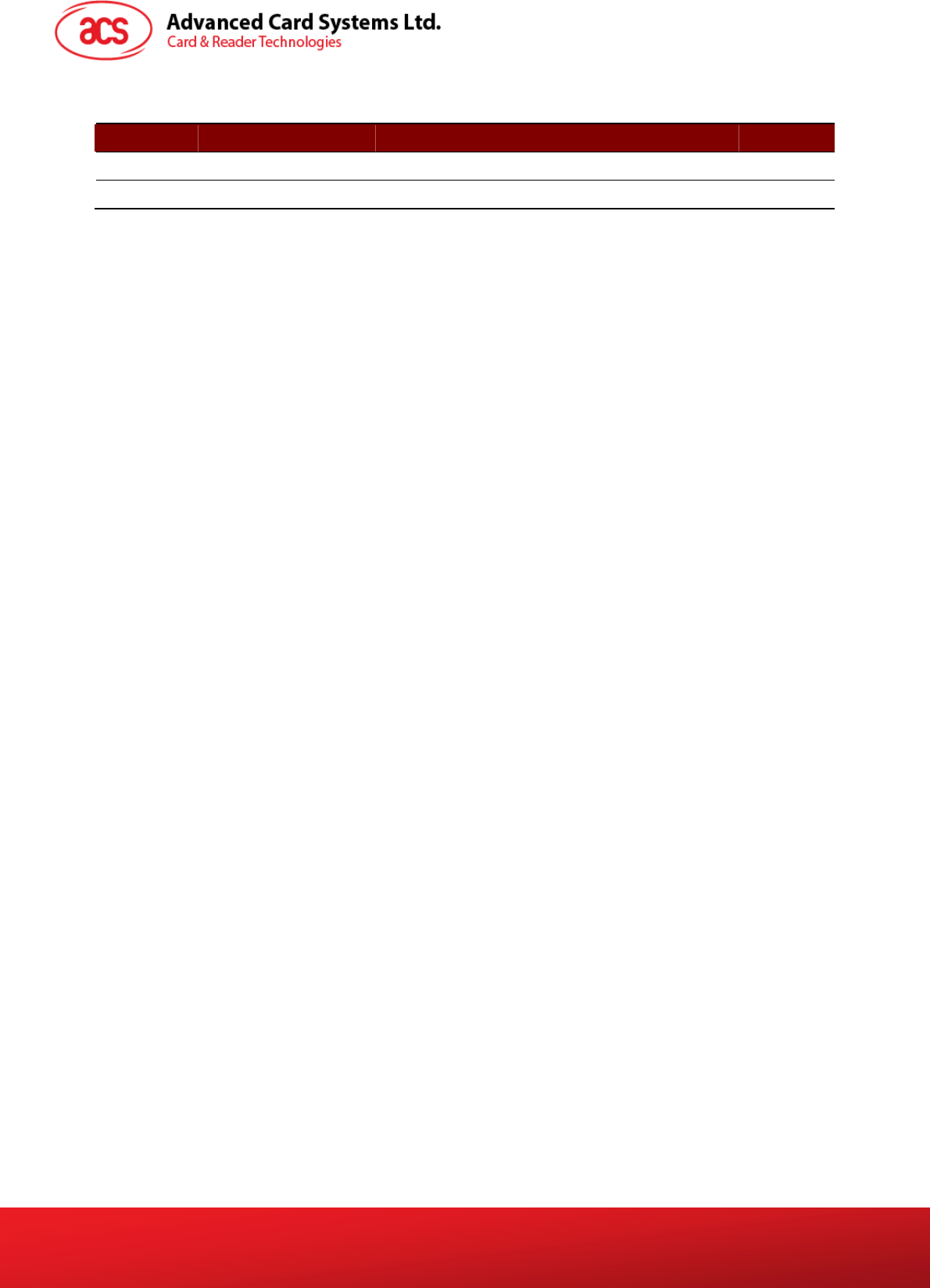
ACR123 User Manual info@acs.com.hk
Version 1.00.00 www.acs.com.hk
Page 2 of 13
Version History
Date By Changes Version
2013-03-27 Kit Au ● First Release 1.00.00
●
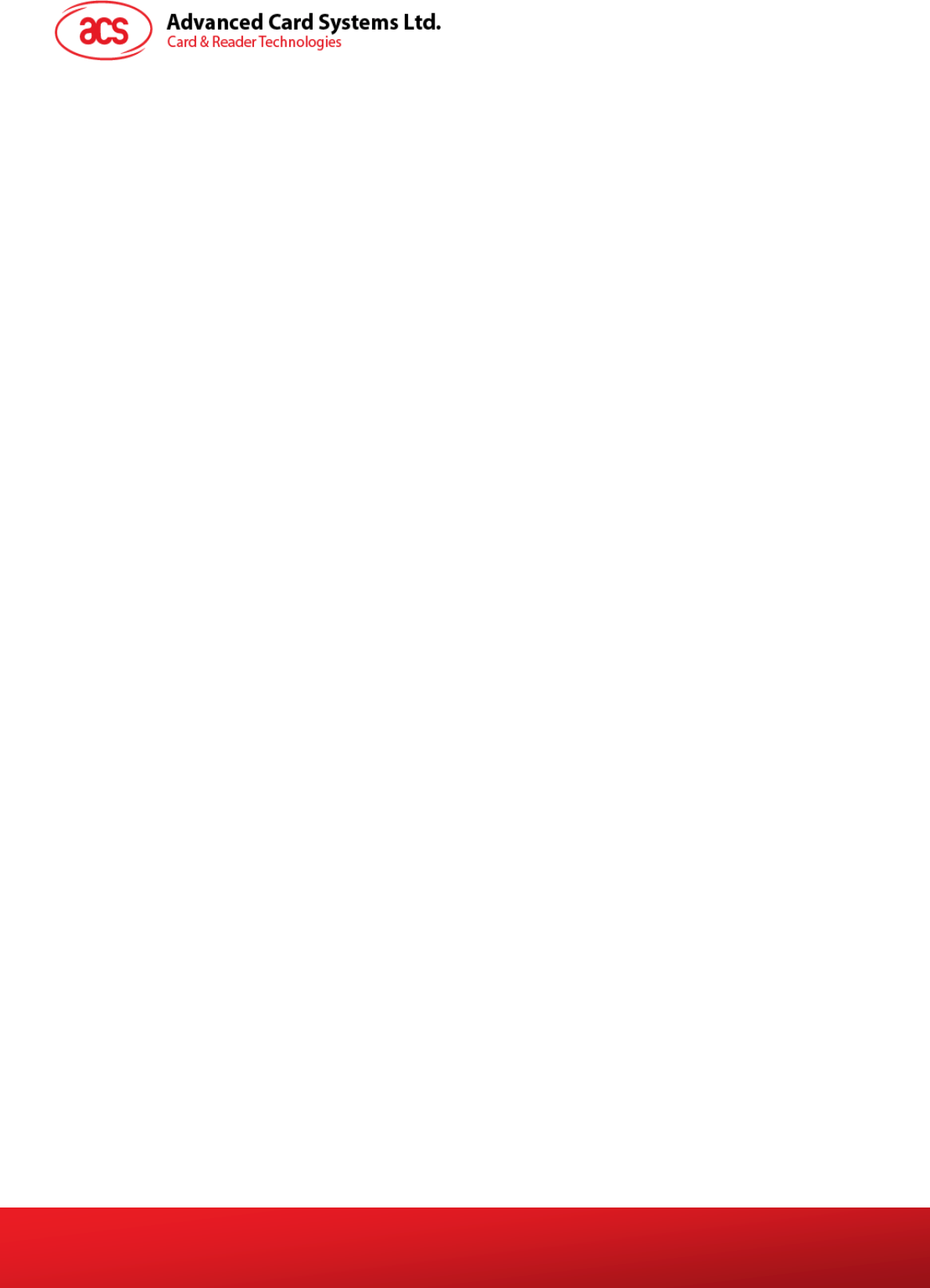
ACR123 User Manual info@acs.com.hk
Version 1.00.00 www.acs.com.hk
Page 3 of 13
Table of Contents
1.0. Introduction ...............................................................................................................4
2.0. Features .....................................................................................................................5
3.0. Architecture...............................................................................................................6
4.0. ACR123 Operating Procedure..................................................................................7
4.1. Driver installation Procedure ........................................................................................................7
4.2. Operation Example.....................................................................................................................10
Appendix A. Parameter sheet ......................................................................................... 12
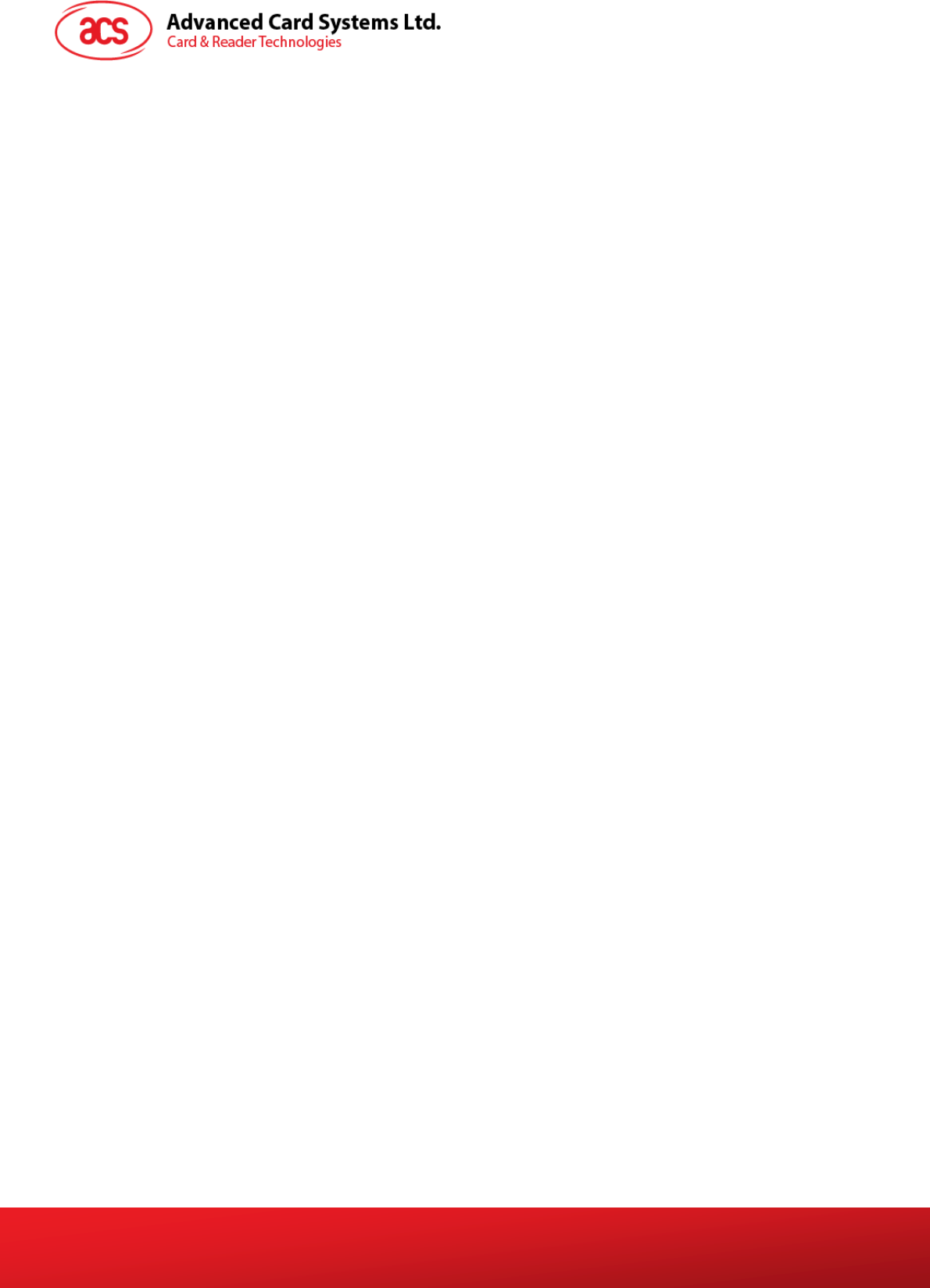
ACR123 User Manual info@acs.com.hk
Version 1.00.00 www.acs.com.hk
Page 4 of 13
1.0. Introduction
The ACS contactless reader is a communication device between the computer and
the smart card through the Serial host interface. It is compliant to the ISO14443
supporting contactless smart card and is also compliant to the MasterCard PayPass
and Visa PayWave standard. The compliance to the PayPass and PayWave
standard widens the supported cards and strengthens the contactless product line’s
salability especially in the payment industry.
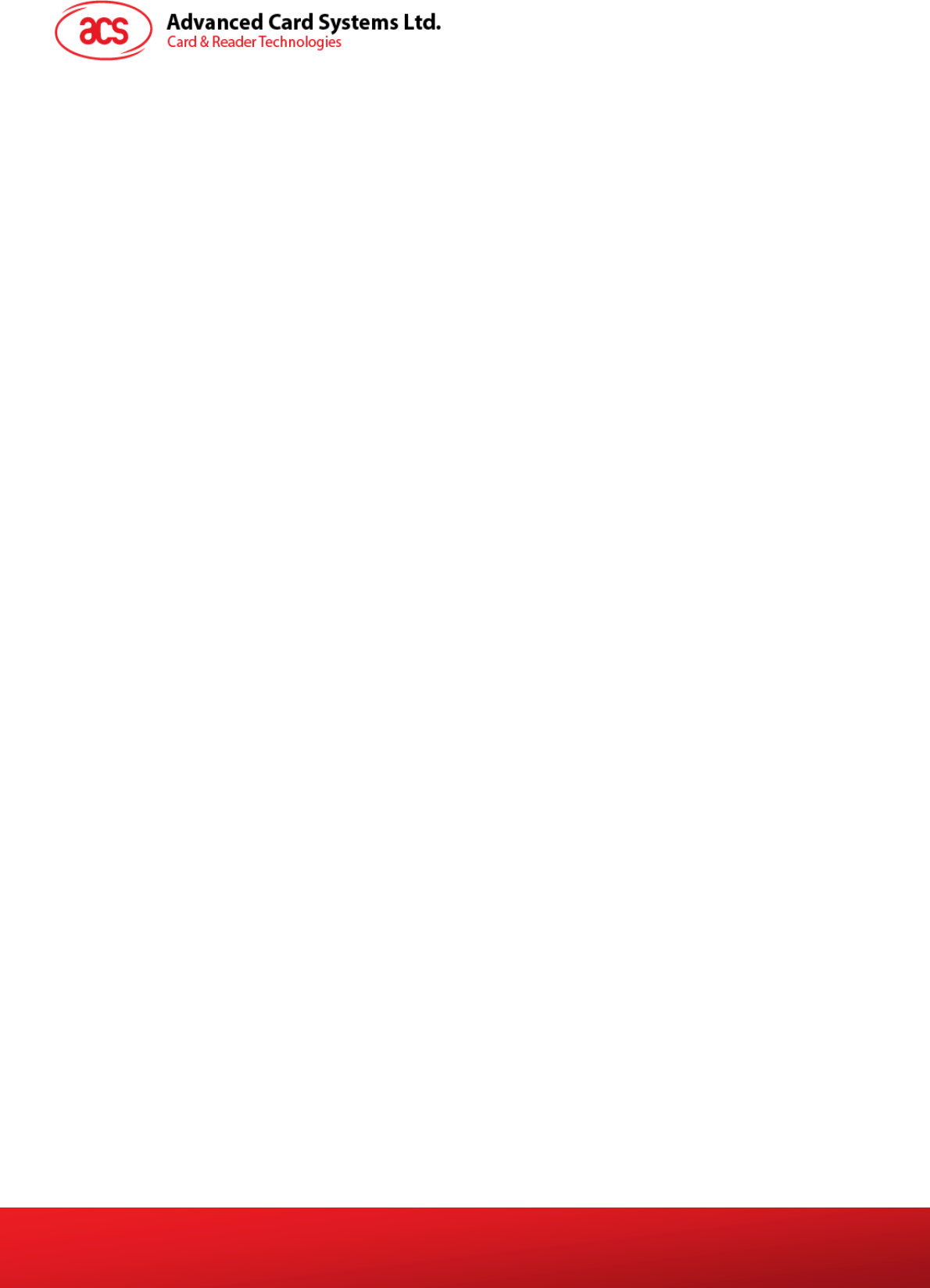
ACR123 User Manual info@acs.com.hk
Version 1.00.00 www.acs.com.hk
Page 5 of 13
2.0. Features
• Supports contactless smart cards
o ISO14443 Types A&B compatible smart card interface
o ISO18092 Tag Support (Phase 2)
o MasterCard PayPass and Visa PayWave Compliant Cards
o High communication speed of up to 848 kbps
o Reading distance of up to 100 mm
• Supports SAM contact cards
o ISO7816-1/2/3 compatible SAM smart card interface
o 3 SAM slots
o Supports T0 and T1 CPU card
• Supports 4 LEDs for user interface
• Supports monotone buzzer/Speak
• Supports mono color LCD (128 x 64)
• RS232 Interface (up to115.2 kbps) with DB9 connector/ USB2.0 Full Speed
• Power supply support USB
• Firmware upgradable
• PC-Linked OS platform support
o Windows 98 and up
o Mac 10.5 and up
o Linux
• Compliance to standards
o CE/FCC
o VCCI
o RoHS
o REACH
o EMV Level 1 and EMV Level 2
• Certifications
o CE/FCC
o VCCI
o RoHS
o REACH
o EMV Level 1 and EMV Level 2
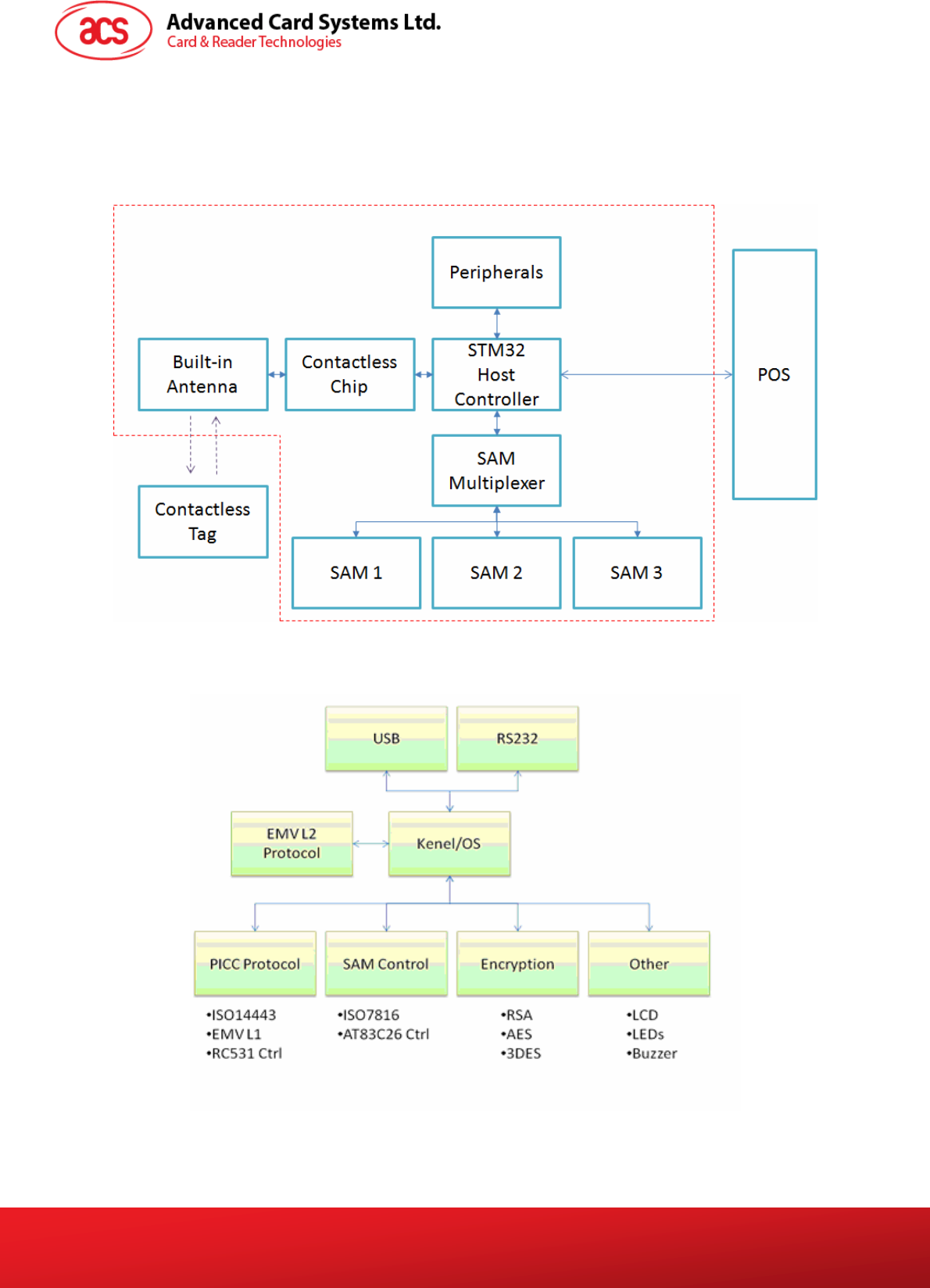
ACR123 User Manual info@acs.com.hk
Version 1.00.00 www.acs.com.hk
Page 6 of 13
3.0. Architecture
STM32 be the main processor for communication with POS, control the contactless chip, SAM and
Peripherals. RC531 act as a contactless chip
To perform communication between Main processor and contactless tag
For software architecture, ACR123 built-in simple OS that used for tasks management, resource
management, etc. Tasks included PICC Polling, SAM checking, Serial and USB communication flow,
etc.
Carrier
Frequency
= 13.56MHz
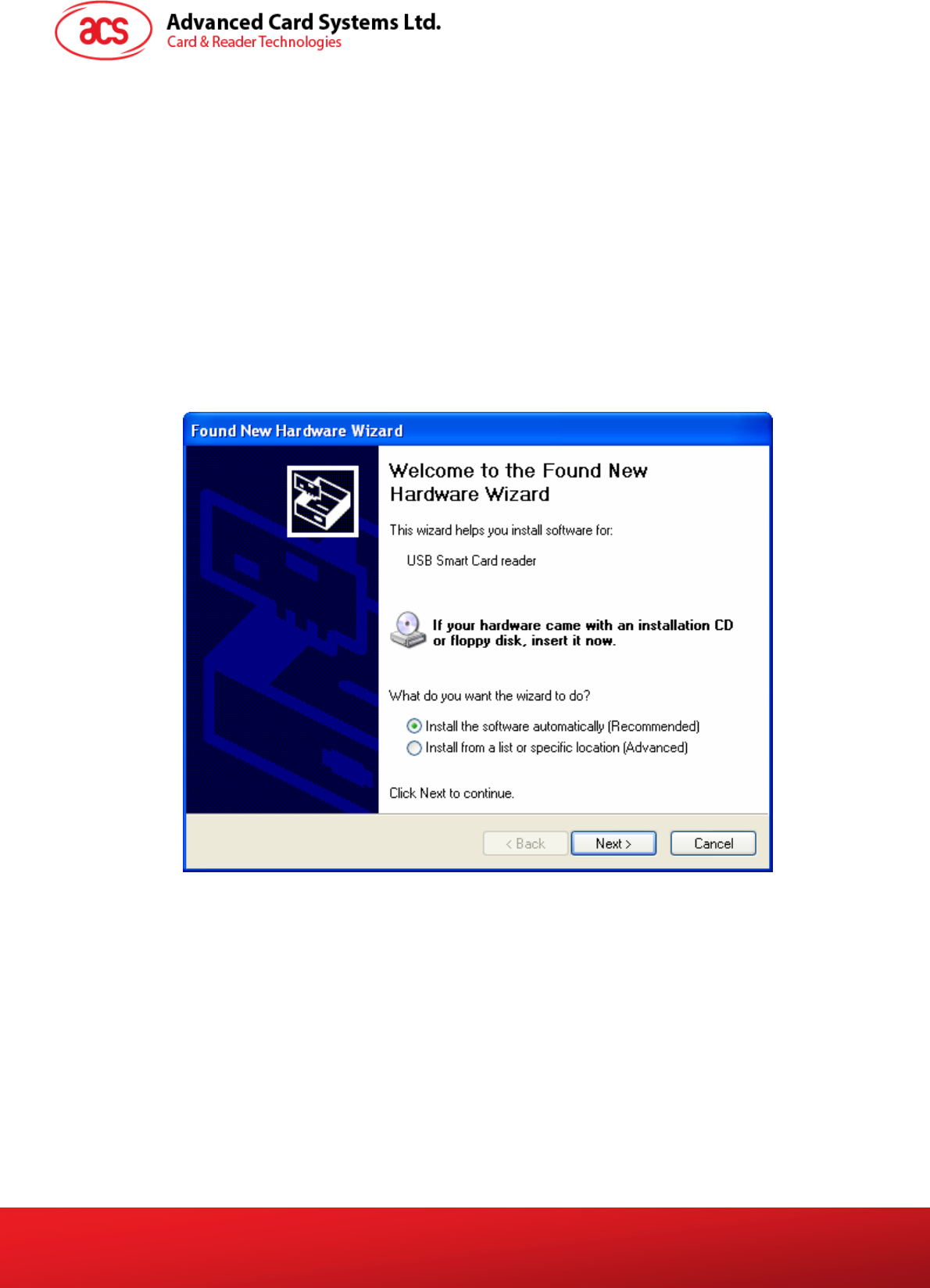
ACR123 User Manual info@acs.com.hk
Version 1.00.00 www.acs.com.hk
Page 7 of 13
4.0. ACR123 Operating Procedure
4.1. Driver installation Procedure
Hardware requires:
ACR123
PC with OS windows XP or above
Software requires:
Driver “Microsoft CCID Driver Version 5.2.3790.2724.rar”
Steps:
1. Extract the file “Microsoft CCID Driver Version 5.2.3790.2724.rar”
2. Plug-in the ACR123 to PC’s USB
3. Wait for driver install message
4. Select “Install from a list or specific location (Advanced)”, then “Next>”
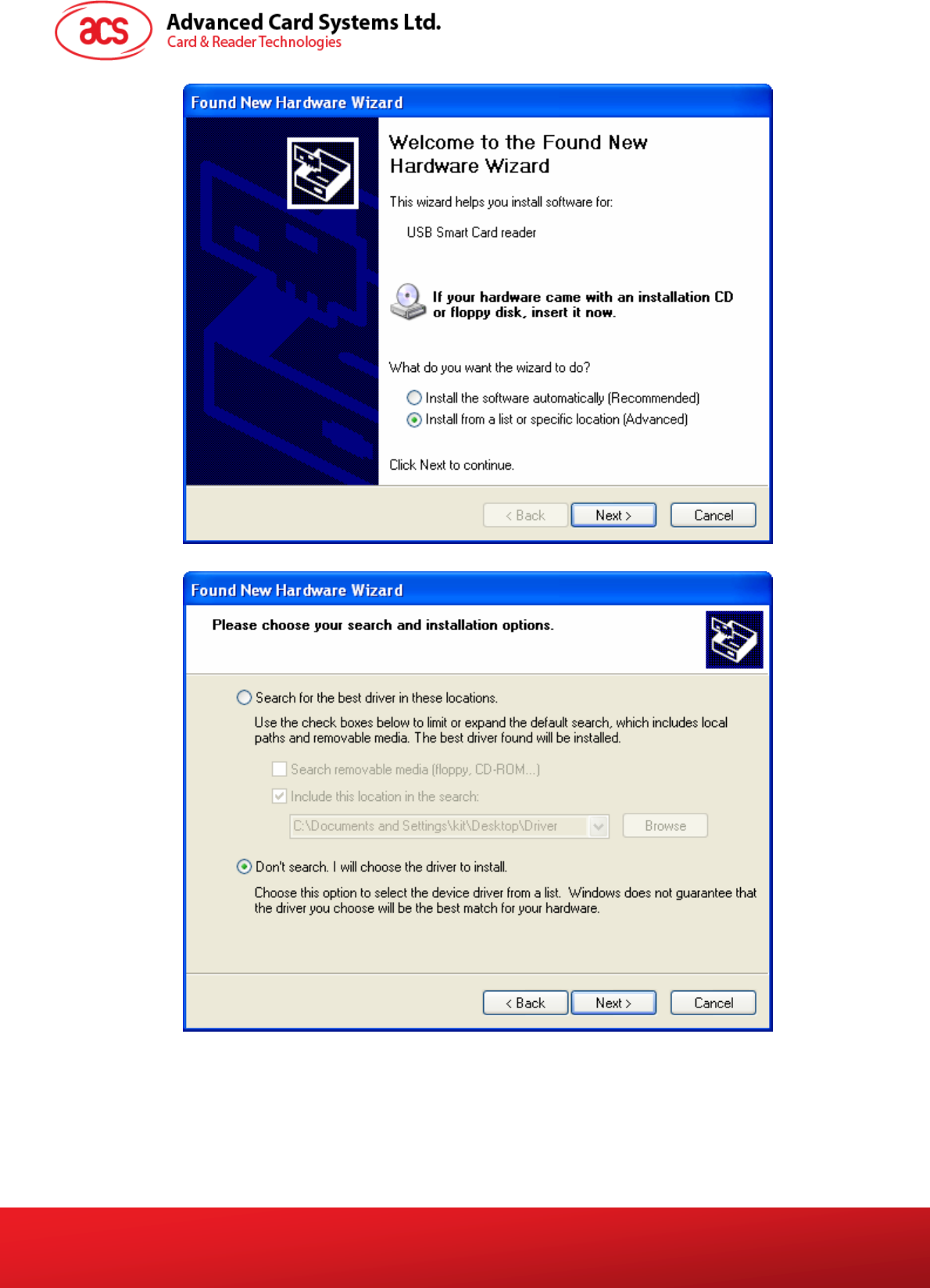
ACR123 User Manual info@acs.com.hk
Version 1.00.00 www.acs.com.hk
Page 8 of 13
5. Select “Don’t search. I will choose the driver to install”, then “Next>”
6. if present “USB Smart Card reader”, select it and then “Next>”
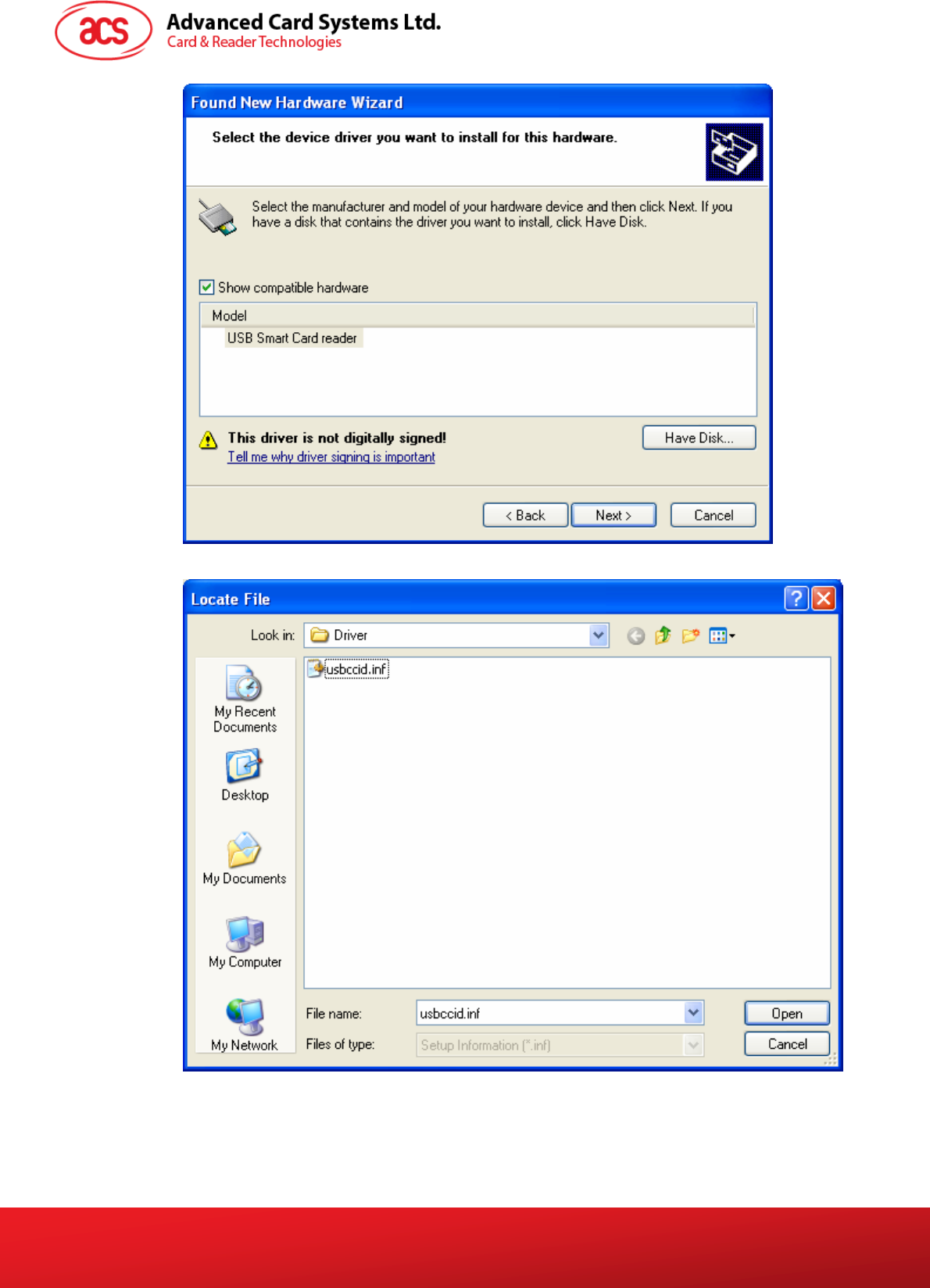
ACR123 User Manual info@acs.com.hk
Version 1.00.00 www.acs.com.hk
Page 9 of 13
if No, click “Have Disk…”
Click “Browse…” to locate the driver (usbccid.inf) location, click “Open”
Select “USB Smart Card reader”, and then “Next>”
7. Click “Continue Anyway”
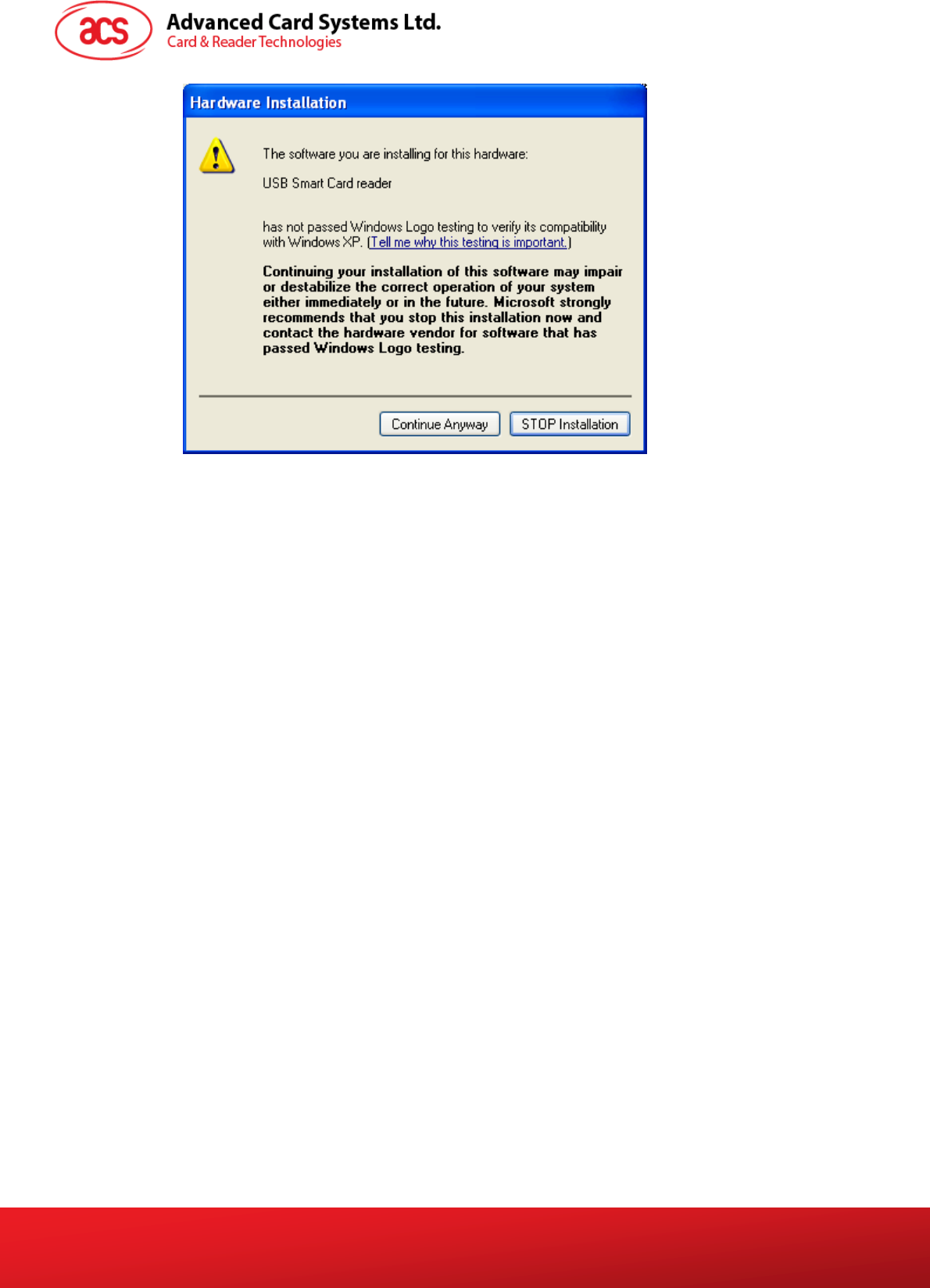
ACR123 User Manual info@acs.com.hk
Version 1.00.00 www.acs.com.hk
Page 10 of 13
8. Wait until the below screen appear, click “Finish” to complete
9. Driver Installation Complete
4.2. Operation Example
Hardware requires:
ACR123 x 1
PC with OS windows XP or above
Test card x 1 (provided by ACS)
Software requires:
APDU.exe (for example)
Steps:
1. Plug in the reader into the PC
2. Place the Card on the top of the reader
3. Open “APDU.exe”
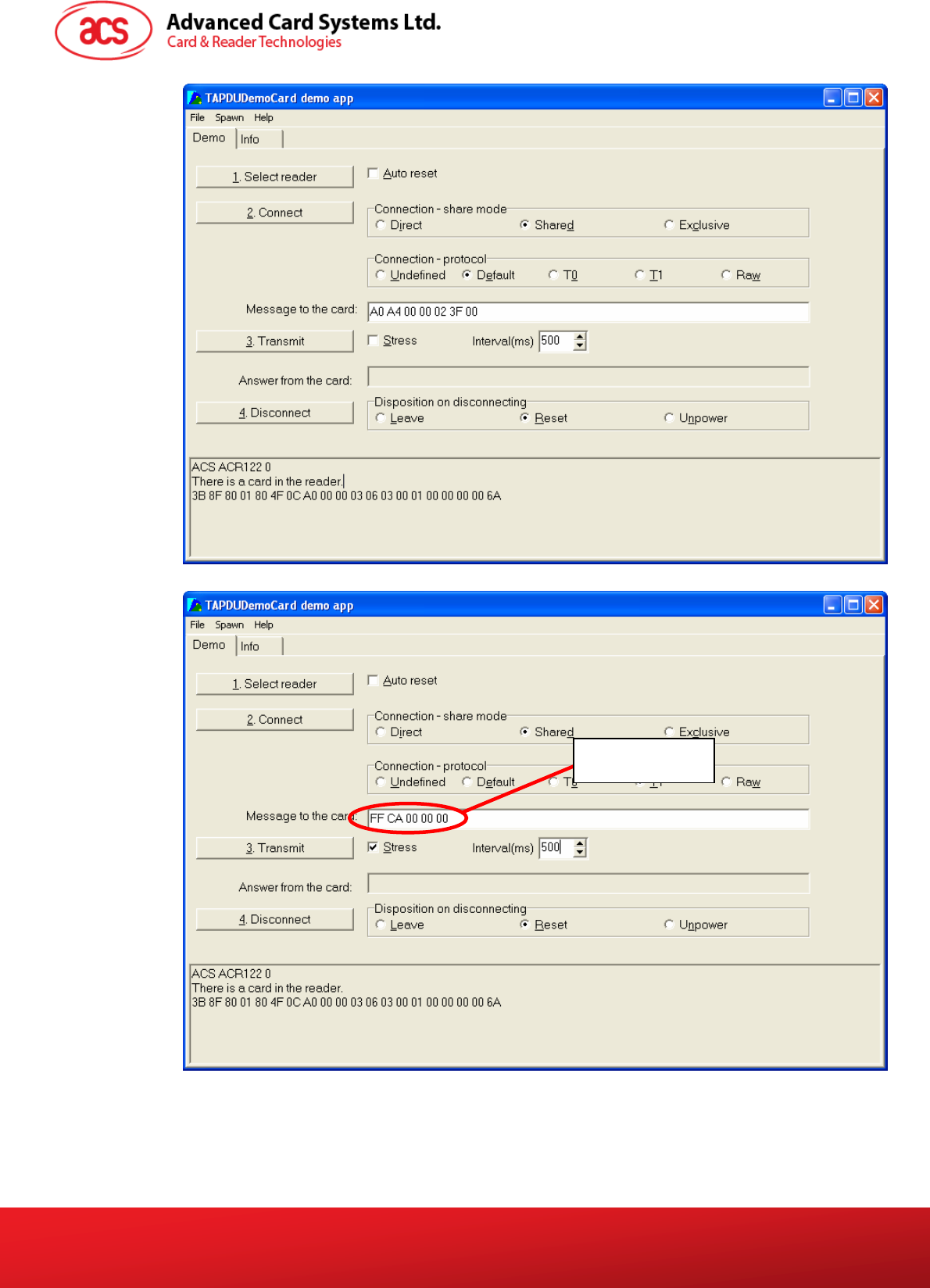
ACR123 User Manual info@acs.com.hk
Version 1.00.00 www.acs.com.hk
Page 11 of 13
4. Select “T1”, and enter the APDU into Message Felid
5. Press “Connect”
6. Press “Transmit” to start the testing
7. Complete the operation
Message Felid

ACR123 User Manual info@acs.com.hk
Version 1.00.00 www.acs.com.hk
Page 12 of 13
Appendix A. Parameter sheet
Device
ACR123 Smart Card Reader/Writer
Power supply
Supply voltage................................ Regulated 5V DC
Supply current ................................ <500mA
Serial Interface
Type ............................................... RS232/RS485
Connector ...................................... supplied together with the reader
Speed............................................. 9600bps – 250Kbps
Universal Serial Bus Interface
Type ............................................... USB, four lines: +5V, GND, D+ and D-
Connector ...................................... supplied together with the reader
Speed............................................. Full Speed Device, 12 Mbps
SAM Smart Card Interface
Standard ........................................ ISO 7816 1/2/3, T=0 and T=1
Supply current................................ max. 50mA
Smart card voltage ......................... 5V / 3V / 1.8V
Smart card read / write speed ........ 9600 – 344kbps
Short circuit protection .................. +5V / GND on all pins
CLK frequency ............................... 4.0MHz
Contactless Smart Card Interface
Standard...............................................ISO 14443 A & B Parts 1-4
Protocol ................................................ISO14443 T=CL for ISO14443-4 compliant cards and T=CL Emulation for MIFARE
1K/4K
Smart card read / write speed................106 kbps, 212 kbps, 424 kbps and 848 kbps
Operating Frequency for Contactless Cards Access
Operating Frequency .............................13.56 MHz
Antenna
Antenna Size..........................................75mm x 75mm
Operating distance.................................up to 50 mm (Depend on Card Type)
Built-in peripherals
1 x Speaker
4 x Single Color LED
4 x Tri-Color Antenna LED Backlight
1 x Micro SD
1 x LCD (128*64 FSTN Type) with backlight
Case
Dimensions .................................... 159.0 mm (L) x 100.0 mm (W) x 21.0mm (H) [without Cradle]
................................... 177.4mm (L) x 100.0mm (W) x 94.5mm (H) [with Cradle]
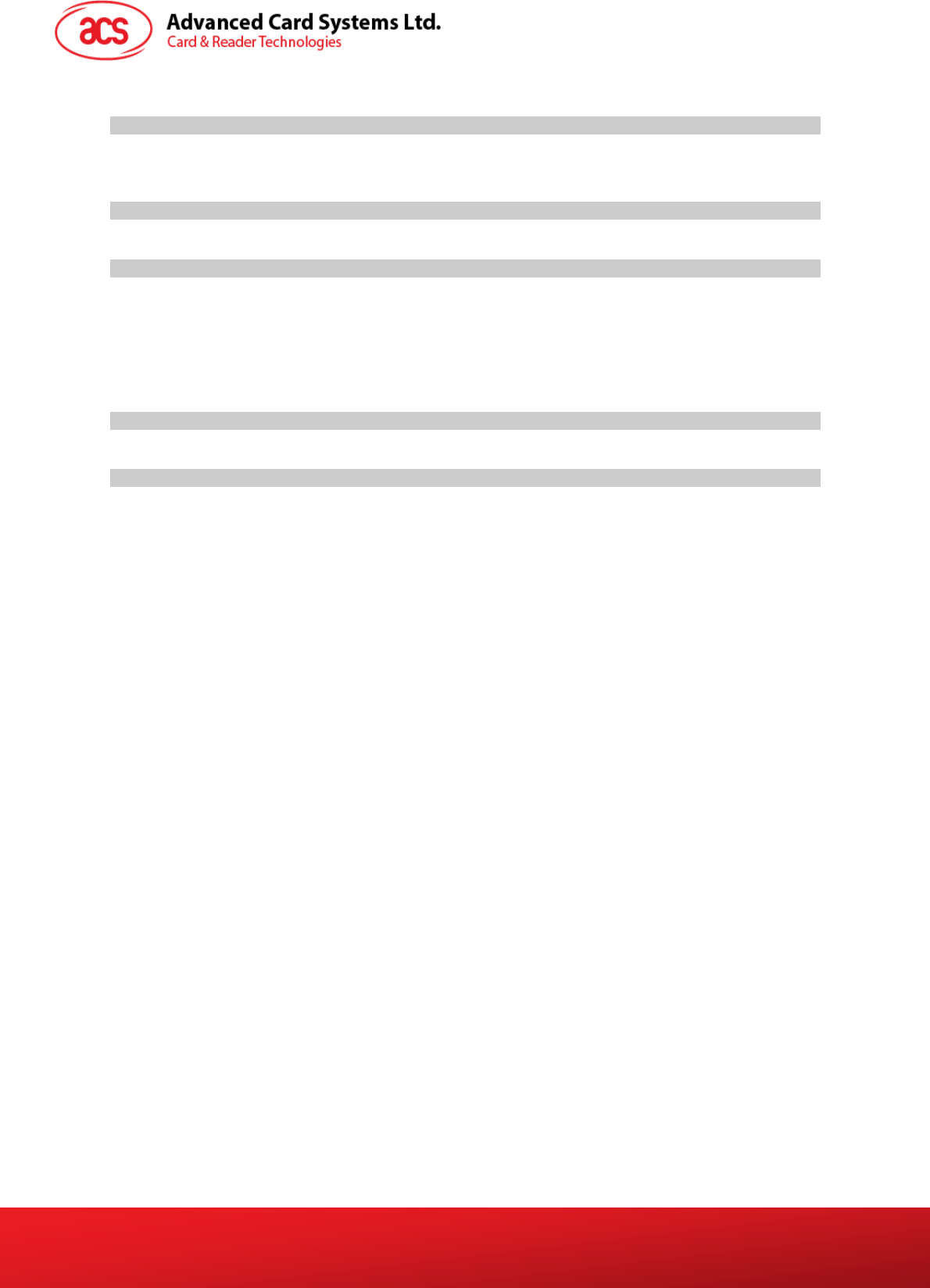
ACR123 User Manual info@acs.com.hk
Version 1.00.00 www.acs.com.hk
Page 13 of 13
Color .............................................. Black
Operating Conditions
Temperature .................................. 0 - 50° C
Humidity ......................................... 10% - 80%
Cable Connector
Length ....................................................2.0m (USB)
Standard/Certifications
CE, FCC
EN300330
EN55022 & EN55024
EN55014
EMV L1 & EMV L2
OS
Windows 98, ME, 2K, XP, 7
OEM
OEM-Logo possible, customer-specific colors, casing, and card connector
FCC Caution:
Any Changes or modifications not expressly approved by the party responsible for compliance could
void the user's authority to operate the equipment.
This device complies with part 15 of the FCC Rules. Operation is subject to the following two
conditions: (1) This device may not cause harmful interference, and (2) this device must accept any
interference received, including interference that may cause undesired operation.
This transmitter must not be co-located or operating in conjunction with any other antenna or
transmitter.